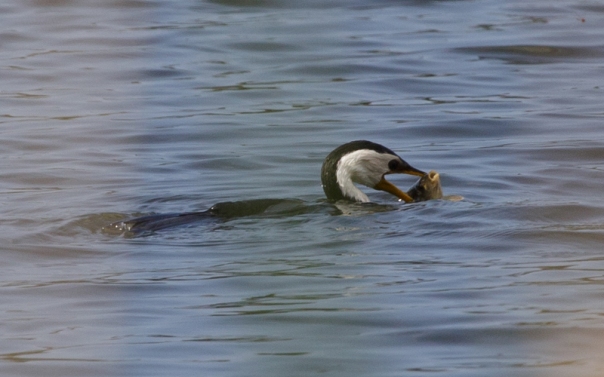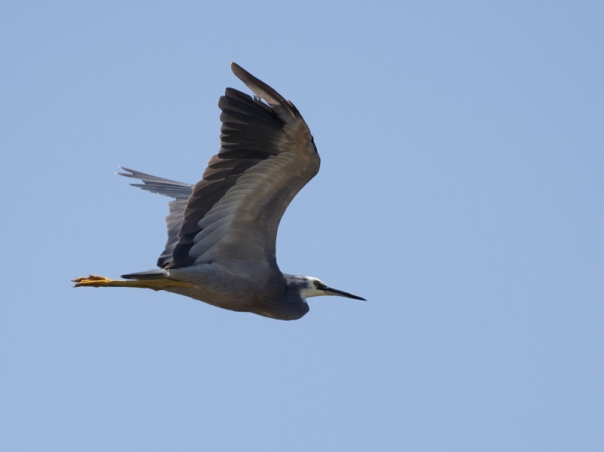27 January 2018
Leaders: Hazel and Alan Veevers; Species count: 60

Despite the forecast for a hot and humid day, 37 members attended the January Beginners excursion. Many small birds were seen in the car park area, including surprisingly high numbers of Superb Fairy-wrens and Willie Wagtails. Soon after the walk started, a Royal Spoonbill was spotted circling high overhead. Whilst watching it, a Brown Goshawk appeared on the scene apparently inspecting the larger bird.

There was great excitement when a Dollarbird (seen two weeks earlier on the recce.) was spotted perched on the top of a tall dead tree-trunk rising from the water. It stayed in place for many minutes, enabling everyone to have a really good look.

A Little Black Cormorant and several Little Pied Cormorants were resting lower down in the same group of dead trees. One Little Pied Cormorant went fishing and caught and ate a decent sized one!



Continuing down-hill to the water level track enabled good views to be had of Australasian and Hoary-headed Grebes, as well as young Eurasian Coots begging for food from their parents.

There were very few ducks on the lake which may be attributed to the presence of some large carp which are known to nibble on the feet of ducks.

A welcome lunch was enjoyed in a convenient shaded picnic shelter near the car park. A bird call tallied 34 species for the morning at the lakes.
About 20 members stayed on to drive down Maddox Road to the shore for the afternoon session. The tide was rather high and no small waders were initially seen. However, several Common Greenshanks were observed as they foraged at the edge of the shore. A large group of Black Swans and Australian Pelicans were disturbed into flight by a very low-flying microlight aircraft.

Nothing much was seen from the track across the salt marsh but walking around the first lake in Jawbone Reserve revealed a remarkable number of species. Included were Great-crested Grebe, Blue-billed Duck, Hardhead, Australasian Shoveler and Musk Duck.

Several Royal Spoonbills on a small island still had their breeding head plumes on display.

They were accompanied by both Chestnut and Grey Teal, mostly resting with their heads tucked under a wing.
Further into the reserve, many different birds were seen resting at the edge of an island in one of the lakes.

These included Black-winged Stilts, Pink-eared Ducks and several Pied Cormorants along with their smaller relatives.

Whilst watching the roosting birds, a White-faced Heron flew gracefully overhead as if to remind us it was time to turn for home.
Returning towards Maddox Road a flock of Yellow-rumped Thornbills were seen in low bushes. Surprisingly these were the only thornbills seen on the excursion.

Back at the shore the tide had receded, leaving more mud banks available for the waders. Pied and Sooty Oystercatchers were on the distant sand-banks, and a small flock of Sharp-tailed Sandpipers with a lone Red-kneed Dotterel were in the drainage channel.

46 species were recorded for the afternoon, with a combined total of 60 for the day. Although it had been hot and humid, everyone felt they had enjoyed some excellent sightings, with ‘Bird of the Day’ clearly awarded to the Dollarbird.
View full bird listing: BM Jan 2018 Bird List Newport Lakes and Jawbone Reserve
Cool photos and neat blog! I initially noticed your “cormorant vs. fish” shots. Wow that looks like a huge (do you know what kind?) fish caught and staring down its captors throat here!
Does the cormorant really manage to win the struggle and gulp that entire thing down okay? Does the fish put up a good fight, if eaten, does the unlucky prey get swallowed wriggling all the way as well?!
Thanks for your interest Kyle. Yes, the Cormorant does swallow the fish whole. It twists it around so that it goes down the “throat” head first. The fish slides down easiest that way, as fins and any other barbs tend to flatten against the body. You can find photos on the Web showing some large fish being eaten this way. I don’t know the type of fish here, but no doubt an expert on fish could tell us. The third photo in the sequence for our Cormorant, showing the bulging neck, was not published in the BLOG. However, here I have added it to the photographs on the blog, to complete the story.
Oh fascinating! I haven’t witnessed an event like this before, it must be some action for life and lunch! Real smart of the bird to consume it headfirst, but don’t fish also have the ability to extend and “push out” their fins in such an elastic neck? Cool you added that third picture too, I think you can even see the fishes tail and it’s really straining (possibly stuck?) the Cormorant’s neck/throat it appears.
I did look at some other photos online and it is quite impressive, but hard for me to imagine! The cormorant must be hungry, but wouldn’t the fish here be desperate to turn around once it hit the stomach and if eaten in such a condition?! Sorry for all the questions, but thanks for any feedback/info and have a nice week! 😉
Sometimes a Cormorant will try to eat a fish which is too big to go down the “throat”. It tries very hard but eventually has to let it go. If it does go in, then it enters the first part of the digestive system which contains substances (e.g. acid) that slowly break down the softer parts of it. The second part of the system crushes harder material like bones, then the third part extracts the waste material and sends it to be excreted whilst the “good stuff” is distributed into the body as nutrients. (Regards, Alan Veevers)